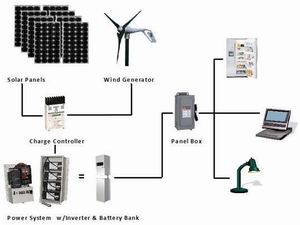Zero Energy Home Plans. Solar Home Plans
|
What is a Zero Energy Home?
 Imagine a home that is not only
energy efficient, but also produces its own power. Just like a typical
home, a Zero Energy Home (ZEH) is connected to and uses energy from
the local electric utility. But
unlike typical homes, at times a ZEH makes enough power to send some
back to the utility company. Annually, a ZEH produces enough energy to
offset the amount purchased from the utility provider, resulting in
net-zero annual energy bills. Imagine a home that is not only
energy efficient, but also produces its own power. Just like a typical
home, a Zero Energy Home (ZEH) is connected to and uses energy from
the local electric utility. But
unlike typical homes, at times a ZEH makes enough power to send some
back to the utility company. Annually, a ZEH produces enough energy to
offset the amount purchased from the utility provider, resulting in
net-zero annual energy bills.
A ZEH combines state-of-the-art,
energy-efficient construction techniques, and equipment with renewable
energy systems to return as much energy as it takes in on an annual basis.
When renewable resources cannot provide the entire home’s power (at
night or on a cloudy winter day) the homeowner purchases energy from the
utility provider. When renewable resources produce more than the house
is using (during sunny days or when no-one is home) power is sent back into
the utility grid. In some cases, the utility provider will operate the
home’s electric meter in reverse, essentially providing the homeowner
with full retail value for their energy.
Why Build a Zero Energy Home?

One of the major issues we are
faced with today is global warming, which is negatively affecting the
environment and worldwide weather patterns. Global warming is a direct
result of harmful gas which is being emitted into the Earth’s
atmosphere. Zero Energy Homes do not produce emissions or atmospheric pollution thus helping to reduce global warming.
Is a Zero Energy Home a Realistic Home?
Once just a concept, Zero Energy
Homes are now a reality throughout the world. The opportunities to
construct ZEHs are growing as solar and other renewable energy
technologies become more affordable. Never having to pay energy bills
is a very attractive concept, but only if achieving this high level
of performance does not greatly increase building costs.
Because of
the design challenges and sensitivity to a site that are required to
efficiently meet the energy needs of a building and occupants with renewable
energy (solar, wind, geothermal, etc.), we apply holistic design principles,
and take advantage of the free naturally occurring assets available, such as
passive solar orientation, natural ventilation, daylighting, thermal mass, and
night time cooling.
| |
|
|